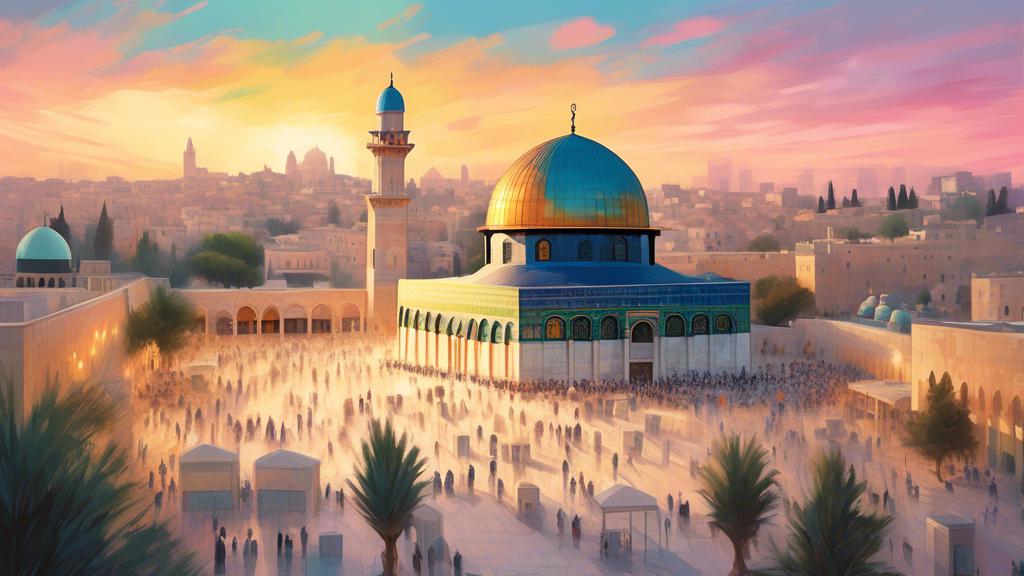Introduction to Masjid al-Aqsa
Masjid al-Aqsa, known as the Farthest Mosque, is one of the most revered holy sites in Islam. Located in the Old City of Jerusalem, it carries immense religious and cultural significance for Muslims worldwide. It is traditionally viewed as the third holiest site in Islam, after Masjid al-Haram in Mecca and Masjid an-Nabawi in Medina.
Historical and Religious Significance
The historical roots of Masjid al-Aqsa date back to the early periods of Islam, but its significance is deeply embedded in Islamic tradition and theology. According to Islamic scriptures, Prophet Muhammad was transported from the Sacred Mosque in Mecca to Masjid al-Aqsa during the Night Journey, or Isra and Mi’raj, which is commemorated annually by Muslims. This miraculous journey not only emphasizes the mosque’s sanctity but also highlights its connection to the prophets of Islam.
Architectural Evolution
The current structure of Masjid al-Aqsa has undergone various modifications over several centuries. Originally built in the early Umayyad period, it has been reconstructed, renovated, and expanded by various rulers. The mosque complex covers an extensive area with several structures, including the Dome of the Rock, an iconic Islamic landmark. Despite its architectural and political transformations, the essence of Masjid al-Aqsa as a place of worship and pilgrimage remains unchanged.
Cultural and Educational Hub
Throughout history, Masjid al-Aqsa has not only been a spiritual center but also a hub for learning and education. It has housed numerous scholars who have contributed significantly to Islamic thought and jurisprudence. The mosque’s libraries are known for their rare collections of manuscripts, making it an important resource for researchers interested in Islamic history and Arabic literature.
The Role in the Israeli-Palestinian Conflict
The location of Masjid al-Aqsa in Jerusalem makes it a focal point in the Israeli-Palestinian conflict. Jerusalem’s status and the mosque’s compound are highly contested and sensitive issues, both politically and religiously. Over the years, tensions regarding control and visitation rights have led to conflicts, affecting the daily life of worshippers and the regional stability.
Religious Tourism and Pilgrimage
Masjid al-Aqsa attracts thousands of pilgrims and tourists annually, who visit the site for prayer, reflection, and to explore its rich historical heritage. For many, the journey is a profound spiritual experience, reinforcing their faith and providing a deeper understanding of Islamic history.
Modern-Day Challenges
Despite its ancient roots, Masjid al-Aqsa faces various modern-day challenges. Issues such as maintenance of the historic site, the logistics of accommodating large numbers of pilgrims, and the ongoing political tensions are persistent concerns. Furthermore, the site must balance the needs and rights of all religious communities, amidst a complex political and social landscape.
International Response and Conservation Efforts
The international community has taken an active interest in the preservation of Masjid al-Aqsa due to its universal heritage. Various global bodies and neighboring countries are involved in the conservation efforts to maintain the mosque’s structure and promote peaceful cooperation among different faiths.
Conclusion
Masjid al-Aqsa remains a symbol of faith, resilience, and coexistence despite the challenges it faces. Its significance goes beyond religious boundaries, serving as a beacon of cultural heritage and human civilization. Understanding its history, significance, and the current challenges it faces is essential for both Muslims and non-Muslims to foster a culture of respect and mutual understanding.
